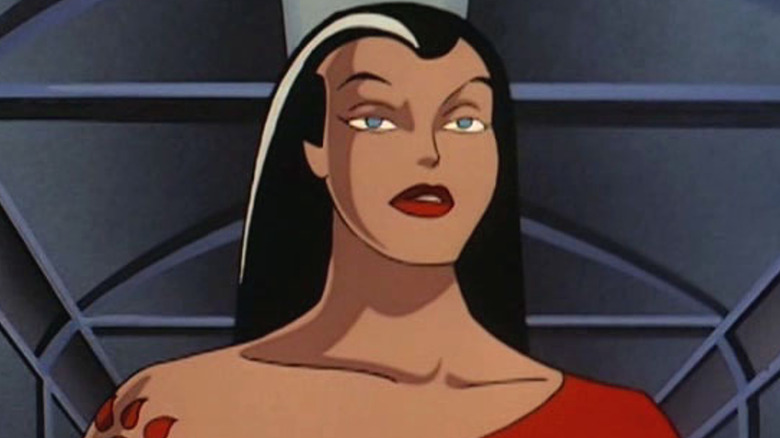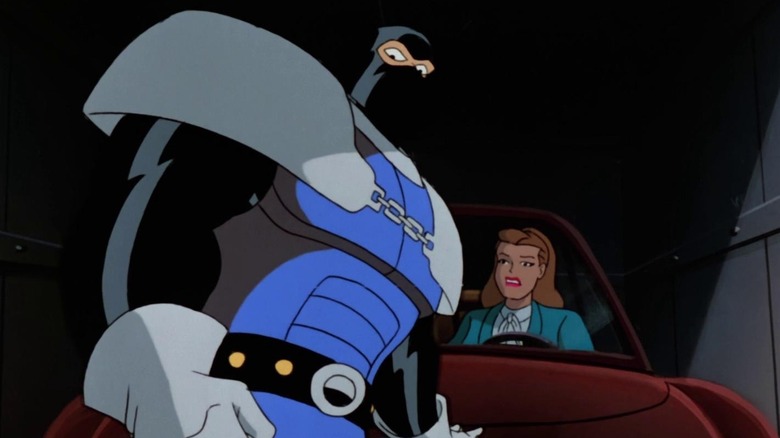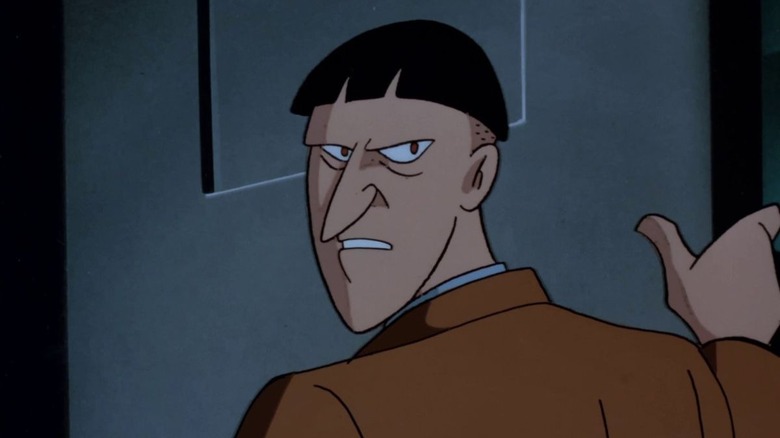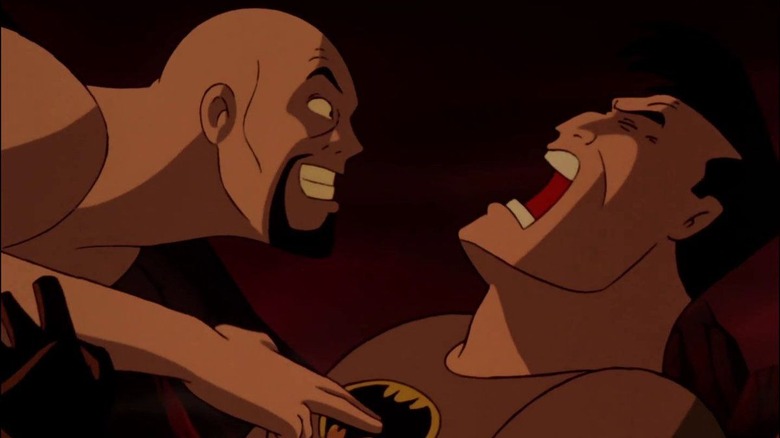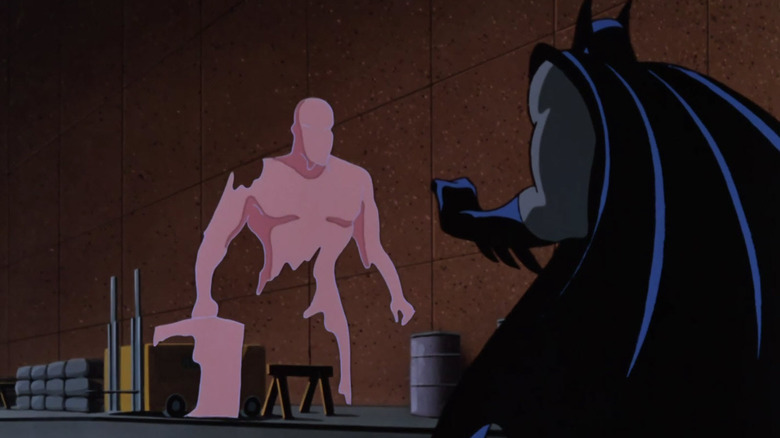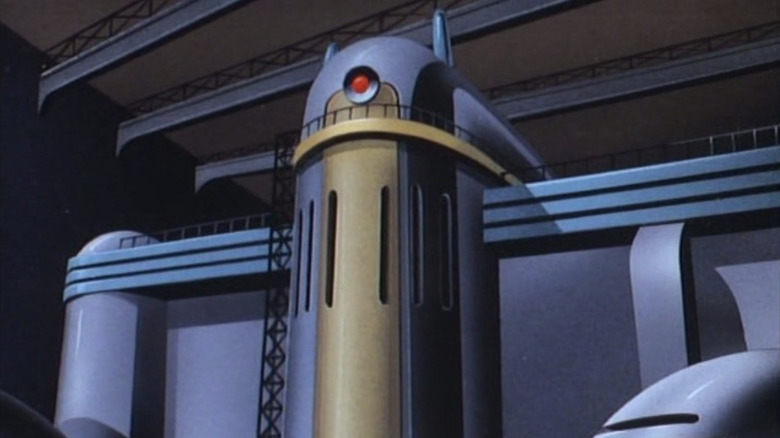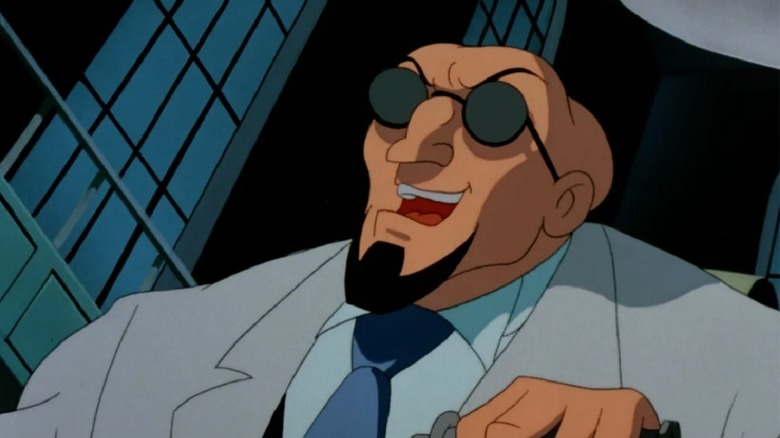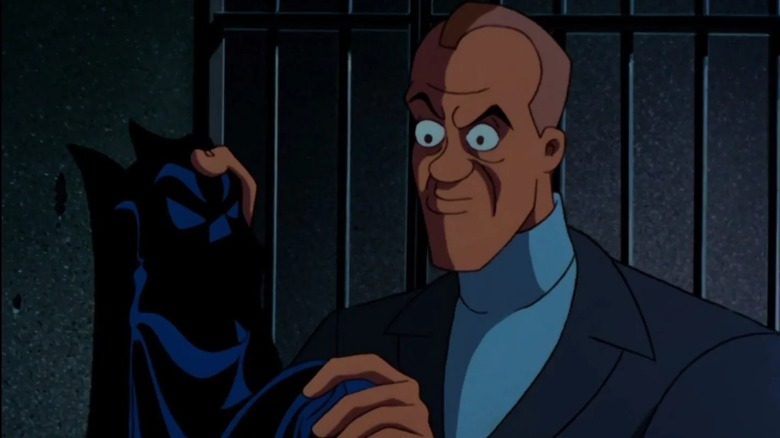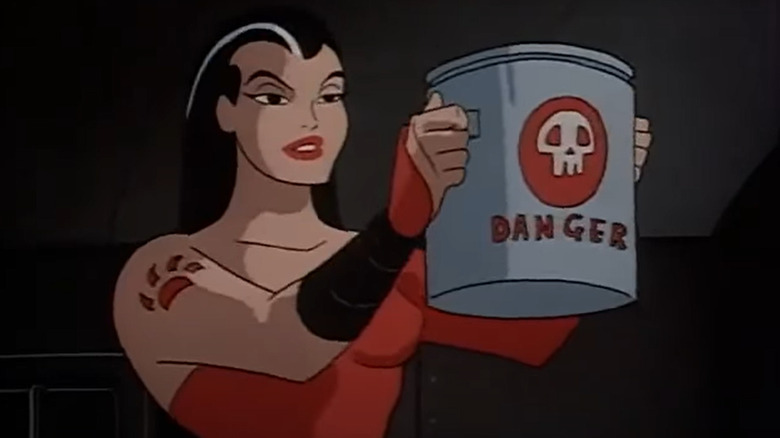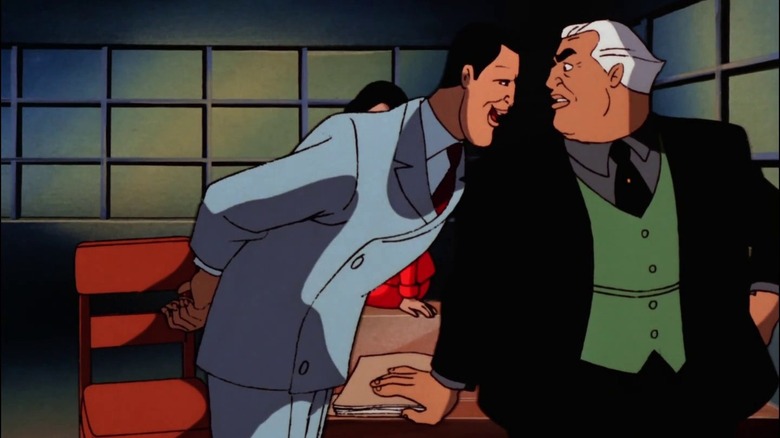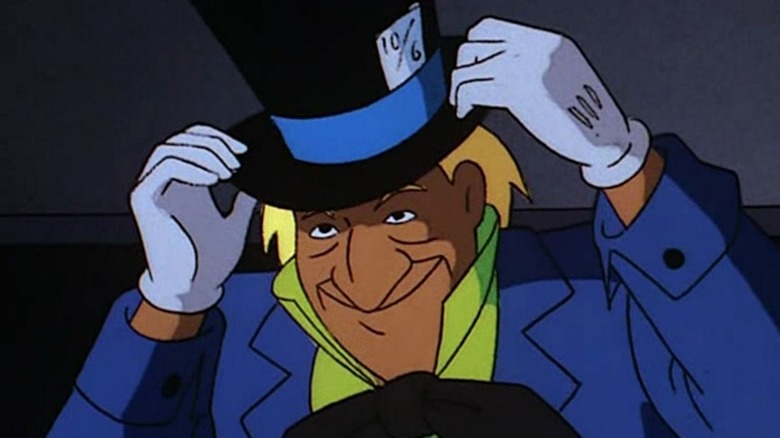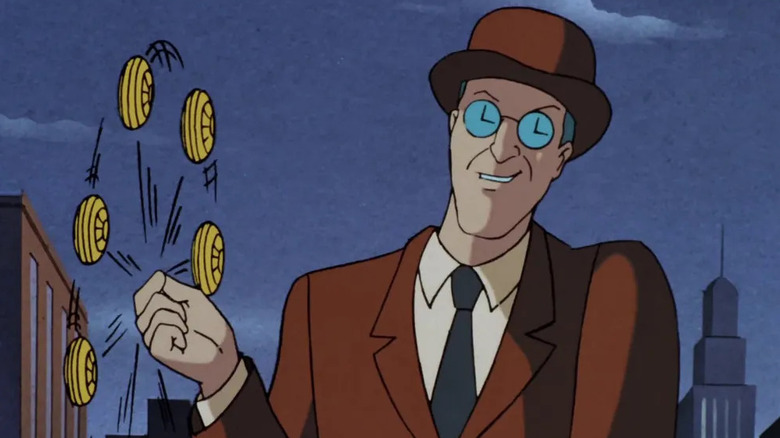The Unsung Villains Of Batman: The Animated Series
As of fall of 2022, "Batman: The Animated Series" celebrates its 30th birthday. Over those three decades, it has remained a powerhouse of a superhero showcase that demonstrates what can truly be accomplished in kids' cartoons. The show's legacy is still relevant to this day as it inspires more adventures for the Caped Crusader, and new fans continue to discover what has become one of the more revered pieces of media featuring The Dark Knight. This is a series that almost doesn't need an introduction anymore, as its accolades are well known, but that doesn't mean that there isn't still more in it to explore or re-experience.
Fans have spent plenty of time discussing the major characters. We've heard a lot about Kevin Conroy and Mark Hamill's portrayals of Batman and the Joker respectively, and how the series introduces eventual staples Harley Quinn and Renee Montoya into the larger "Batman" mythology. However, hidden in the shadows of specific moments or the depths of individual episodes remain a few unsung performances worth spotlighting. This is a time to revisit those villains who shine; the ones who truly test Batman, or simply offer us a stunning story but aren't popular enough to warrant their own comics or movie. Lesser known though they may be, here are a few of the baddies that refuse to go down without leaving their mark on Gotham.
Lock-Up
Lock-Up is an original creation of "Batman: The Animated Series," but to say he didn't become as famous as Harley Quinn would be an understatement. His real name is Lyle Bolton, Arkham Asylum's chief of security, which means he's in charge of all the prisoners residing in those walls and he takes his job seriously. He goes too far, and Arkham board member Bruce Wayne ironically won't abide civil rights violations being committed under his watch. When Bolton is fired, however, he decides to try his hand at the vigilante racket, dressing up in a costume and apprehending lawbreakers himself. This makes him Batman's problem.
Bolton's identity as Lock-Up is easily figured out and he doesn't have a creative costume, but there are good traits behind the somewhat uninspired chains and nightstick. We talk about villains having relatable motivations and believing they're in the right — this is a perfect example, even if Lock-Up is incredibly delusional. He might be a one-note brute, but his story brings up several questions about the practice of housing criminals and the potentially darker themes in Gotham. The finale has a great moment where Bolton seems happy to be in jail where he can keep a better eye on his charges, but that's the end of his story. Had viewers been given more time with the character, he most likely would be better developed and more fondly remembered.
Professor Achilles Milo
Somehow, there just aren't enough evil scientist characters. Professor Milo doesn't feel like he fits into the normal mad scientist stereotype. He's a geneticist who loves splicing genes (just not his own) and can create a plague when needed, but he keeps his criminal operations closer to the streets and out of a laboratory and lets his bowl cut do the talking as his most identifying feature. This is a character who is adapted from the comics, but in the cartoon universe, he starts out working for crooked businessman Roland Daggett. Eventually he joins Project Cadmus in "Justice League Unlimited," where he gains the distinction of possibly the only character associated with "Batman: The Animated Series" to be viciously killed by a character associated with "Superman: The Animated Series."
Milo's genius is somewhat respected, but his expertise as a villain may be lacking. He's often seen biting off more than he can chew and putting himself in situations against a stronger force he didn't plan for (like Doomsday, for instance). This doesn't mean he can't get results — the man did create a werewolf, after all. As a character, he might've been better remembered if he appeared in different episodes. He's easily overshadowed by Catwoman in "Cat Scratch Fever," and "Moon of the Wolf" feels a little out of left field due to the aforementioned werewolf. Batman doesn't typically fight classic movie monsters ... not in this series, anyway. Treat Williams provided the smarmy voice for Milo — another small aspect that helps him stand out in the two episodes that feature him.
Kyodai Ken
Batman is essentially a ninja, which means it makes perfect sense to put him up against someone with the same training and skills. It's interesting to see flashbacks when Bruce isn't some martial arts master and hasn't figured everything out yet but is still determined to do the right thing. We meet his biggest rival from that time, Kyodai Ken, in the dojo where Batman was forged. This is a man who doesn't have beef with the Caped Crusader, but hates Bruce Wayne because of his societal standing and a grudge from their time training together. That's enough for Kyodai to swear a vendetta.
This mercenary ninja is smart in the way he attacks the Wayne fortune, and even smarter when it comes to his art. They say a fighting style is a fingerprint, and as soon as Kyodai sees Batman in combat, he immediately knows the identity of his nemesis. Little things like this make his two appearances feel like a real threat, especially in the episode "Day of the Samurai" where he learns a technique to kill someone with a single touch. He also chooses to die in a volcano over being saved by his sworn enemy, but at least he acknowledges Bruce as a worthy foe before he is consumed by magma.
Lloyd Ventrix
"See No Evil" is a brilliant standalone Batman adventure about a man who is bad at being a father, and who goes down a terrible path attempting to make his family whole again. When that fails, he tries to kidnap his young daughter in an invisible car. Okay, that may be getting ahead a bit. Lloyd Ventrix isn't just a man with a great last name, he's a criminal who realizes the potential of an electric cloth that can make things invisible. He does the smart thing and makes an entire suit out of it, not realizing that prolonged exposure to the material can cause physical and mental distress. Perhaps this is why he pretends to be an invisible friend named Mojo to his daughter so he can creep into her room and leave her gifts he stole.
The audience is almost given enough time to feel for the unfortunate family man, but his time wearing the toxic material means he gets less sympathetic and more motivated. His robberies attract Batman's attention and soon the Dark Knight has to get creative. Invisibility certainly isn't a new concept, but it's something fun for the hero to contend with, and the action toward the end of "See No Evil" is incredibly entertaining. Though this would be the only appearance for Ventrix, Batman remembers this experience enough to name him as a potential suspect in a later episode, "Time Out of Joint," and that's a true sign of leaving an impression.
H.A.R.D.A.C.
Everyone loves having a super-intelligent computer until it starts thinking for itself. A genius named Karl Rossum created H.A.R.D.A.C. (Holographic Analytical Reciprocating Digital Computer), an advanced AI intended to help solve all of his problems, or at least address the grieving father's issue with the death of his daughter. Things go a little too far, however, when the computer decides that the best way to protect human life is to replace humans with robotic duplicates. H.A.R.D.A.C. begins switching out some of the most influential people in Gotham with his metal doppelgangers, but his plans are eventually discovered and thwarted in a wonderful two-part episode, "Heart of Steel."
Naturally, this villain is a bit robotic — even though he's voiced by the onetime Johnny Bravo, Jeff Bennett — but his soft matter-of-fact speaking tone and spectacular creations make him a memorable foe. On a couple of different occasions, he seems close to accomplishing his goals and besting Batman. H.A.R.D.A.C. appears to be inspired by HAL 9000 from "2001: A Space Odyssey," and his inclusion brings an entertaining and gripping high science fiction feel to the already robust playground the show has established. The villain goes on to make an even bigger impact in the episode "His Silicon Soul," which shows that one of H.A.R.D.A.C.'s back-up plans — a robot replicant of Batman — survived the initial altercation. Together, these episodes make for a glorious trio of metal-based mayhem.
Hugo Strange
The character of Hugo Strange — whose first appearance in 1940 predates that other Doctor Strange by a few decades – has a ton of potential, much of which is seen in the comics and video games of the "Batman" franchise, but fans only received one episode featuring Strange in "Batman: The Animated Series." Essentially, he's an evil psychiatrist, someone who tries to inspire a sense of professionalism and trust, but he also gives off some horrible vibes. His methods are hard to deny when the results are brought up, as Strange is one of the few rogues to discover Batman's secret identity. Even though the Caped Crusader outsmarts him in the end of "The Strange Secret of Bruce Wayne," it feels like these two are destined to do battle again, which they almost were. There was another episode of "Batman: TAS" planned with the character titled "Mind Games" that was never produced, but it would have seen Strange up the stakes even further from his last outing.
"The Strange Secret of Bruce Wayne" isn't a bad episode, but it makes the good doctor feel like a small-time criminal — another genius associated with Roland Daggett who should be aiming a bit higher. When Strange stumbles onto Bruce's secret identity with his mind-reading technology, it's due to a simple series of glorified blackmail schemes, but the ending of the episode is well worth the price of admission. Interestingly enough, Strange was also briefly slated to appear in "Justice League Unlimited" for a cameo, but what would've been his second DCAU appearance was apparently canceled once again.
Josiah Wormwood
He's often referred to as "The Interrogator" because Josiah Wormwood is a mercenary whose specialty is elaborate traps that put the victim in peril, convincing them to give up the important information or lose their life. That alone makes the interrogator sound like someone who could pose quite a challenge for the Dark Knight. "The Cape and Cowl Conspiracy" is a fantastic episode that doesn't really need a follow-up, although that means viewers only get to see Wormwood in one episode. Adapted straight from "Detective Comics" #450 from 1975, this episode is a battle of wits and preparation where Batman is almost outmatched.
The story sees Wormwood hired by someone who Batman embarrassed publicly, and the price he wants paid for this offense is the cape and cowl — a true symbol of The Bat. It isn't too shocking to say that the mercenary succeeds, considering his resume, seemingly outmatching his foe until Bruce reveals that he remembered to wear his secondary mask that night. Wormwood's got lots of cool traps, however, Batman gets the last laugh when he lets us know that he was beating The Interrogator at his own game all along. The final scene in the episode even shows the hero taunting him by sending Wormwood the prize he worked so hard for.
Red Claw
Red Claw holds the honor of making her debut in "Batman: The Animated Series" — just like Harley Quinn, Renee Montoya, and Lock-Up. Even though the two-parter episode "The Cat and the Claw" fell later in the production order, its first installment was the first "Batman: TAS" episode aired, possibly because it was timed to capitalize on the success of 1992's "Batman Returns" and the popularity of Catwoman. Either way, this gave Red Claw a highly coveted spot and most likely made her more memorable for those who watched the cartoon when it initially aired. One of the other main factors elevating this ruthless mastermind is the excellent thick-accented voice work by a pre-Janeway Kate Mulgrew, who properly conveyed strength and determination for the brand-new female villain.
"The Cat and the Claw, Part 1" isn't one of the better episodes when it comes to action due to its focus on the relationship between Bruce and Selina Kyle, but the show makes up for that tremendously in the second installment. Not only does Red Claw come off as an effective terrorist by stealing a plague to threaten Gotham, but it's all done during a riveting train heist. This femme fatale returns in another adventure that requires her to kidnap Alfred Pennyworth, allowing fans to learn more about his past as she shoots missiles at London. This original creation was an excellent villain, and even though we didn't see more of her in the DCAU, her dominance paid off years later as she finally debuted in the comics.
Rupert Thorne
Batman fights a lot of mob bosses. While many hide behind the mask of a philanthropic businessman, everyone knows Rupert Thorne is bad news. With his white hair, booming voice, and pure willingness to do anything it takes, Thorne could have easily ruled the streets if not for a string of mishaps and failures in his organization that stripped away his power and livelihood. He's still a resourceful enemy of Batman, and the man who hired Bane to deal with Gotham's savior.
One of the things most remember about Thorne is that not only did he cause trouble for Batman, but the Caped Crusader could never seem to keep him down. Thorne's influence is too great in a corrupt system and even when evidence is brought up against him, it seems to mean nothing. Thorne also has a major hand in creating Two-Face, leading to a treacherous war between the two crime bosses. Thorne appears in a total of nine episodes, giving him way more exposure than many other "Batman" characters with more recognizable names. The show made him a bigger deal to Gotham's status quo than he is in other iterations of the city, and several of his episodes granted deeper looks into what a man like him is truly willing to sacrifice. Thorne's essentially a building block for the show as a whole.
The Mad Hatter
A name that almost feels a little too well-known for this list, the Mad Hatter is a member of Batman's rogues' gallery that a good number of casual fans may still recognize. Even with that being so, all these years after the cartoon did him so many favors, Jervis Tetch has never truly been elevated. Fans haven't seen him in a "Batman" movie or as the focus of one of the Caped Crusader's other significant projects outside of the comics. Some viewers may consider him silly, having a gimmick based on "Alice in Wonderland," but it's more about the man under the hats.
The Mad Hatter is in six episodes of "Batman: The Animated Series," but two of those are more like extended cameos. He does, however, participate in what some believe to be the best story of the show, "Perchance to Dream." This mind-bending adventure about an alternate world that's too good to be true is an incredible journey with a fantastic ending, and even though Jervis only participates in the ending, his involvement leaves a lasting impression. Roddy McDowall breathes fire into the character that is undeniable, putting a force of madness behind the Hatter's twisted smile. We are never meant to truly sympathize with him, but the Mad Hatter demonstrates a strong sadness, vulnerability, and lashes out in anger at those he claims to love. Jervis goes from violently swinging an ax to pitiful cowardice and that range makes him feel incredibly fleshed out.
Clock King
This is a perfect example of a character that exists in the comics but was initially regarded as a joke. Now, the revamped Clock King, in the form of Temple Fugate is a much more compelling, cold, and threatening character. His motivations seem a little trivial — he wants revenge against Gotham Mayor Hamilton Hill, who cost him a lot of money by accidentally making him late to an important appointment — but maybe not every villain on "Batman: The Animated Series" needs a sympathetic backstory. Now with a set of clock-themed weapons, new specs, and a plan, Clock King returns ready to exact revenge on Mayor Hill and dispose of Gotham's caped hero as well if need be.
Obviously, someone calling themselves the Clock King is focused on punctuality. Fugate is a master strategist and planner, an excellent athlete and swordsman, and he never shows up without doing his research. He's studies Batman to the point of knowing how long it takes him to throw a punch and is aware of most of the items at his opponent's disposal. Later, his schemes get a little more sci-fi when he acquires a machine that lets him slow time down around him. In "Justice League Unlimited," he's brought in to coordinate a plan for assaulting the home base of the JLA.
